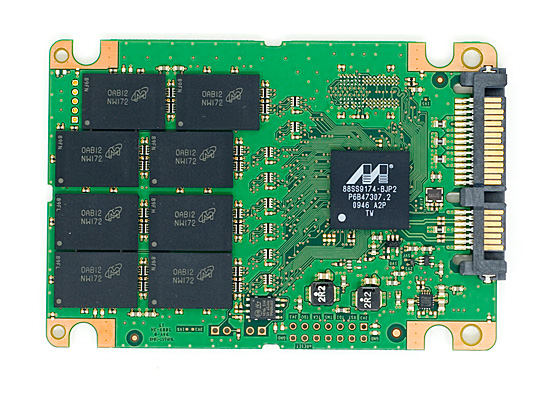6Gbps SATA Performance: AMD 890GX vs. Intel X58/P55
by Anand Lal Shimpi on March 25, 2010 12:00 AM EST- Posted in
- Storage
Final Words
AMD’s ATI acquisition was about bringing graphics to the portfolio with the eventual goal of integration into the CPU itself. We’ll see the first of that early next year with Llano. But as AMD goes down this integration route, it needs to make sure that its chipsets are at least up to par with Intel’s. Many have complained about AMD’s South Bridges in the past, but with SB850 we’ve actually seen some real improvement. There still appear to be some strange behaviors and I don’t like that there’s any discrepancy between AMD’s reference board and retail 890GX boards, but these results look very promising.
AMD’s native 6Gbps implementation manages to outperform both Marvell and Intel’s controllers in the 4KB random write test by a substantial margin. AMD’s sequential read speed is lower than the Marvell controller, and random read speed is lower than Intel’s 3Gbps controller. With a bit of work, AMD looks like it could have the best performing SATA controller on the market.
Intel’s X58 still has a few tricks left up its sleeve - it manages to be a very high performing 3Gbps SATA controller. Other than in sequential read speed, it’s even faster than Marvell’s 6Gbps controller with a 6Gbps SSD - although not by much.

Marvell makes the only 6Gbps SSD controller today. By next year that will change.
The P55 and H55 platforms are far less exciting. Any 6Gbps controller connected off the PCH is severely limited by Intel’s use of PCIe 1.0 slots. Unfortunately this means that you’ll have to use the 16 PCIe 2.0 lanes branching off the CPU for any real performance. That either results in you limiting your GPU to only 8 lanes or dropping back down to PCIe 1.0 if you have two graphics cards installed. ASUS’ PLX solution is an elegant workaround for the specific case of a user having two graphics cards and a 6Gbps SATA controller on-board. Our tests show that it does work well.
We have to give AMD credit here. Its platform group has clearly done the right thing. By switching to PCIe 2.0 completely and enabling 6Gbps SATA today, its platforms won’t be a bottleneck for any early adopters of fast SSDs. For Intel these issues don't go away until 2011 with the 6-series chipsets (Cougar Point) which will at least enable 6Gbps SATA.










57 Comments
View All Comments
sparkuss - Thursday, March 25, 2010 - link
Anand,I was going to maybe get two C300's for my current build. Do we consumers need to wait for your update before we invest in these?
We know it died, but I haven't been able to find any other reliability statistics collated anywhere to make a buying decision on.
sparkuss - Thursday, March 25, 2010 - link
Sorry, I missed the Update link in the upper corner.vol7ron - Thursday, March 25, 2010 - link
Great review. Not much to be said. There was a little bit of puffery at the end, in AMDs favor.I'm sure most companies have faster controllers/BIOSs to be released. Rather than saying AMD is something to look out for, for some reason I'd think Intel would have something greater.
As you mentioned, the on-die controller should have lower latencies - could you ask them about this? Perhaps some of the PCI bandwidth is being chewed up by something else, or perhaps the latencies are too low, causing a check/repeat bottleneck? (or maybe this a marketing ploy to release something faster in the future)
Dzban - Thursday, March 25, 2010 - link
Because AMD has native 6Gbps and they are improving drivers. With intel chipsets you can't phisicly increase speed further.vol7ron - Thursday, March 25, 2010 - link
I don't like how Intel switches between [Mb/s & Gb/s] and [MB/s & GB/s]. It'd be nicer to not have to translate 480Mbps into 60MB.I guess the issue was at first past I almost equated the 480Mb/s to the 500MB/s right under it.
jejeahdh - Thursday, March 25, 2010 - link
You should not type dates in that format, and if you had an editor, he or she should absolutely stop you from doing such things. People have expectations. You might think it's no worse than the ever-present traditional ambiguous formats of the US and Europe (m/d/yy(yy), d/m/yy(yy)) which are bad enough, but at least it's an old and well recognized problem that people are used to living with, so long as it uses slashes. People with knowledge of standards, though, use dashes for ISO date format, yyyy-mm-dd which is also perfectly sortable. By mixing and matching styles haphazardly, you're only propagating the notion that anything goes, causing people to stop and wonder for 12 days out of every month. If you're deliberately adopting the style commonly used in the Netherlands (I had to look it up) and advocating its use for an international audience, I cannot imagine why.I know it seems crazy to harp on this and I kind of agree . . . but I am just so surprised to see it here, written by a detail oriented technically minded accomplished writer.
strikeback03 - Friday, March 26, 2010 - link
If this is in response to the IOMeter build, that might be the way it was named by its creator, not Anand. Also, I would imagine 6-22-2008 is m-dd-yyyyassassin37 - Thursday, March 25, 2010 - link
Hey Anand, Why isn't the X-58 gigabyte native 6gbs board on the write benchmarks?assassin37 - Thursday, March 25, 2010 - link
never mind I read why, legacy modevailr - Thursday, March 25, 2010 - link
Intel releases SSD friendly AHCI/RAID driver:http://www.pcper.com/#NewsID-8538">http://www.pcper.com/#NewsID-8538